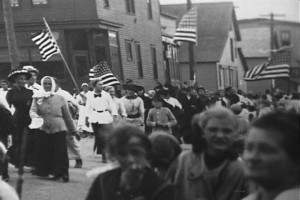 By late August of 1913, authorities in Calumet were facing a problem that was “becoming more perplexing each day.” Women were mixing it up with strikebreakers, scabs, deputies and national guardsmen. “This development is perplexing,” read an article dated August 28th, “as the men are timid in resisting such attacks.” The women were “spitting in the faces of deputies and hurling curses and slurs upon the civil guards”; they “pummeled workmen returning to their homes from the mines,” and when one workman fought back, “this angered the dozen or more women in the crowd and a free-for-all melee followed.”
By late August of 1913, authorities in Calumet were facing a problem that was “becoming more perplexing each day.” Women were mixing it up with strikebreakers, scabs, deputies and national guardsmen. “This development is perplexing,” read an article dated August 28th, “as the men are timid in resisting such attacks.” The women were “spitting in the faces of deputies and hurling curses and slurs upon the civil guards”; they “pummeled workmen returning to their homes from the mines,” and when one workman fought back, “this angered the dozen or more women in the crowd and a free-for-all melee followed.”
Brawling, spitting, cursing women — female furies loosed in the streets — came to stand for the social disorder that swept over Calumet in 1913. Local storyteller Jack Foster could think of no better way to communicate how bad things had gotten than to tell us, during the last interview we did with him, that in 1913 “you had women running around with brooms, dipped in the outhouses, slashing at you if you went to work. You can’t imagine what we went through here.” In Jack’s account, and in many popular accounts of the time, these women were something that ordinarily would be unimaginable.
But these were extraordinary times. The word often chosen to describe the problem these women in Calumet represented — perplexing — suggests a difficult entanglement of social logic. Things had gotten all mixed up, confounded. The women fighting in the streets were defying authority in all senses of the word: not just the deputized and enlisted forces of law and order, but also the social forces that ordinarily kept women in their place, or at least prevented them from roving in bands and taking over the streets.

After watching their husbands and young men getting killed by the so called “law and order” (what a joke), they probably had a bad case of Momma Bear syndrome.
You wrote, “were defying authority in all senses of the word: not just the deputized and enlisted forces of law and order,” these deputized hoods and murders came to break the strike in any way they could – any way. They didn’t care about these people. I am just now learning about the “Massacre”. The books by Steve Lehto, DEATH’S DOOR and SHORTCUT, have been very informative. It takes time to read and understand, but as a former court employee I could comprehend alot. Mr. Lehto did a great job writing these books.
Also, the “1913 Massacre” film with Arlo Guthrie shows how this town is still in pain. These people still live side by side with hurt, pain, and anger. The people that hurt them are long gone. The money is gone and so the companies left. The people there are there because that is their home.
I pray for them. It’s been 100 years and they need closure. You don’t need guns to kill people. Words cut more than knifes and guns. It’s still the same old US – “look what your greed for money has done.” (Woodie Guthrie words)
Pingback: SURVIVALIST INTEL | Women on the Verge of a Social Breakdown | 1913 Massacre
Pingback: SURVIVALISTS BLOG | Women on the Verge of a Social Breakdown | 1913 Massacre